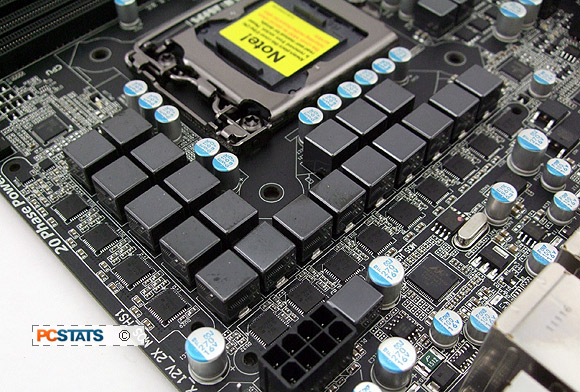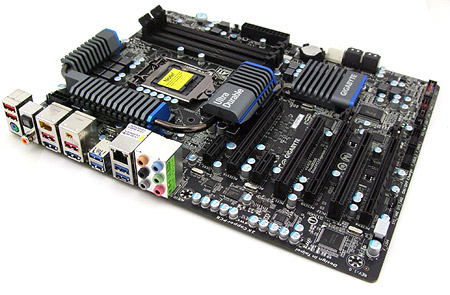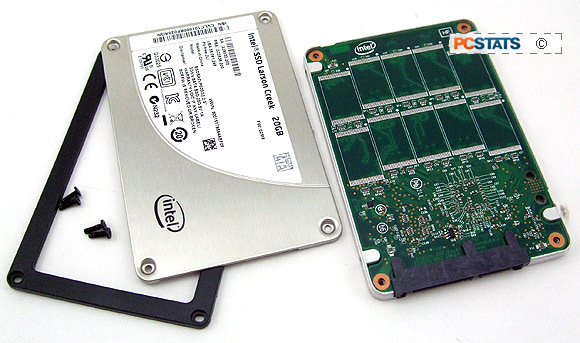PCSTATS
measures total system power draw (watts) with the aid of an Extech 380803 AC
Power Analyzer and A-PFC compliant Seasonic SS-760KM power supply. The meter is placed
between the 120V AC outlet and the PC power supply and the computer stressed.
Total system power draw is recorded and compared to the PC's idle state.
| Total System Power Draw |
|
Idle
|
CPU
Loaded |
GFX
Loaded |
|
Intel Core i5
2500K
nVidia Geforce GTX470
|
102W
|
168W
|
274W
|
|
|
(Idel @ desktop) |
(via Prime95) |
(via
3DM06) | |
Gigabyte's GA-Z68X-UD5-B3 motherboard uses a 20-phase power
VRM design built around 'Driver MOSFETs' which combine the functions of a
driver, high MOSFET and low MOSFET into one board mounted component. This
integrated circuit improves power efficiency, reduces heat and has a smaller
footprint than previous circuit designs. Flanking the CPU socket are Japanese
made all solid-state capacitors and ferrite choke cores.
|

Gigabyte VRM circuitry includes MOSFETS and
LOW RDS Ferrite Chokes.
|
According
to Gigabyte, all of its Intel Z68 platforms are VRD12 qualified and use an
Intersil PWM controller to switch between power phases dependent on system power
loads. The board is built on a 6-layer PCB with 2oz. copper substrate that pulls
double duty as a board level heatsink for surface mount devices like the driver
MOSFET.
Gigabyte Boosts Power to
USB ports
Since
Computex last year, Gigabyte has boosted the electrical capabilities of its USB
ports to better support demanding external hard drives or the charging
requirements of peripherals like the Apple iPad. Standard USB 2.0 ports are
limited to 500mA power loads, USB 3.0 devices to 900mA. The Gigabyte
GA-Z68X-UD5-B3 motherboard supports USB 2.0 power demands up to 1500mA, USB 3.0
devices up to a maximum 2700mA. This won't change the performance of your USB
devices, rather it will help prevent power hungry USB devices from conking out
unexpectedly. If you use a lot of USB devices (and who doesn't?) you'll
appreciate the added flexibility of filling all the USB ports up without
resorting to powered USB hubs.
Time to wrap up this review up and summarize our
thoughts on the Gigabyte GA-Z68X-UD5-B3 Motherboard.
Conclusion - It All Comes Down To This:
Do You Need Video Transcoding?
I'm a fan detailed reviews that conclude with the
essential points and don't rehash all the technical specs ad nauseam. So if
you've skipped ahead to read the conclusions first, you've missed a good
thrashing of what Intel Smart Response Technology is (critical!) and how well it
actually works.
PCSTATS also told you why we think TouchBIOS is better
alternative to poorly coded and the superficially glossy UEFI BIOS craze
sweeping the motherboard industry. You may have also missed the 360-degree
motherboard photo highlights gallery and baseline overclocking results for this
jet black, 6-layer slab of PCB from Gigabyte.
 To sum up, whether or not the Gigabyte
GA-Z68X-UD5-B3 motherboard is worth buying for your next socket 1155/Sandy
Bridge computer system in large part comes down to how you answer this question
- do you absolutely need Quick Sync accelerated video transcoding?
To sum up, whether or not the Gigabyte
GA-Z68X-UD5-B3 motherboard is worth buying for your next socket 1155/Sandy
Bridge computer system in large part comes down to how you answer this question
- do you absolutely need Quick Sync accelerated video transcoding?
If you do, you don't get that with this board because
the Gigabyte GA-Z68X-UD5-B3 is one of the few Intel Z68 motherboards at launch
time that doesn't have onboard video ports. Without those, it can't take
advantage of the LucidLogix Virtu driver and as such any and all video
transcoding will be as comparatively slow as the MPEG2-to-MP4 example PCSTATS
illustrated.
The lack of onboard video ports and the inability to run
Quick Sync accelerated video transcoding aside, the Gigabyte GA-Z68X-UD5-B3
motherboard is in most other respects a pretty fantastic Intel Z68 platform;
it's got plenty of connectivity, it's got plenty of expansion space to suit
mainstream PC requirements and most importantly it can run Intel Smart Response
Technology.
The ATX sized board has eight USB 3.0 ports, including a
very convenient dual-port 3.5" front bay bundled in. The bare minimum of two
internal 6Gb/s SATA III ports is a bit disappointing though, PCSTATS would have
preferred at least two more internal SATA III jacks.... The videocard PCI
Express slots are well spaced, memory slots and so forth are easy to access, and
as with most Gigabyte motherboards the build quality and component selection is
top notch.
 Naturally for a certain segment of users, the
big advantage with Intel Z68 boards like the Gigabyte GA-Z68X-UD5-B3 is going to
be Intel Smart Response Technology - the ability to assign a caching SSD to speed up systems installed to
traditional hard disk drives.
Naturally for a certain segment of users, the
big advantage with Intel Z68 boards like the Gigabyte GA-Z68X-UD5-B3 is going to
be Intel Smart Response Technology - the ability to assign a caching SSD to speed up systems installed to
traditional hard disk drives.
PCSTATS touched on the in's and out's of Intel SRT already, suffice to say we have a positive
impression of what this technology can do for users. Keep in mind that your
reviewer falls into the category of users for whom SSDs are 50% too small and
40% too costly... with 10% trepidation thrown in for first hand experience of
what happens when an SSD kicks the bucket.
Hint - no data recovery program in existance that can
breath life into your files after that. Clearly though, if you plan on
installing Windows 7 to a SSD, the impact of Intel SRT is a moot point.
If you're considering the leap into a first-class Intel
socket 1155 motherboard based on the Intel Z68 platform, the Gigabyte
GA-Z68X-UD5-B3 will set you back about $270 CDN ($250 USD £130
GBP). It can be found at NCIX $279, Canada
Computers $279 and Infonec $284.
If integrated graphics and video transcoding acceleration aren't among your
list of requirements you'll be very happy with the
GA-Z68X-UD5-B3 motherboard.... but like our time testing Intel P67
platforms, I can't help but think there's an unused bit of technology in that
Core i5 2500K processor that I should at least have the
option of using, after all, that's the whole point of the Intel Z68 chipset
isn't it?

Find out about this and many other reviews by joining
the Weekly PCstats.com Newsletter today! Catch all of PCSTATS
latest reviews right here.
Related Articles
Here are a few other articles that you might enjoy as
well...
- Intel Smart Response Technology and Intel 311 Larson Creek
SSD Review
- ASUS P7P55D Premium Intel P55 Express Motherboard Review
- Intel 6-Series Chipset Recall - Sandy Bridge Intel P67
& H67 (v2.2)
- Biostar TH67XE Intel H67 Motherboard - FIRST LOOK
- MSI Computer P67A-GD65 Intel P67 Motherboard - FIRST
LOOK
- Gigabyte GA-P67A-UD7 Intel P67 Motherboard - FIRST
LOOK
- ECS H67H2-M Intel H67 Motherboard - FIRST LOOK
- Gigabyte GA-P55A-UD6 Intel P55 Express Motherboard
Review
- Biostar TA890FXE AMD 890FX Motherboard Review
- ASUS P7P55D-E Pro Intel P55 Express Motherboard Review
